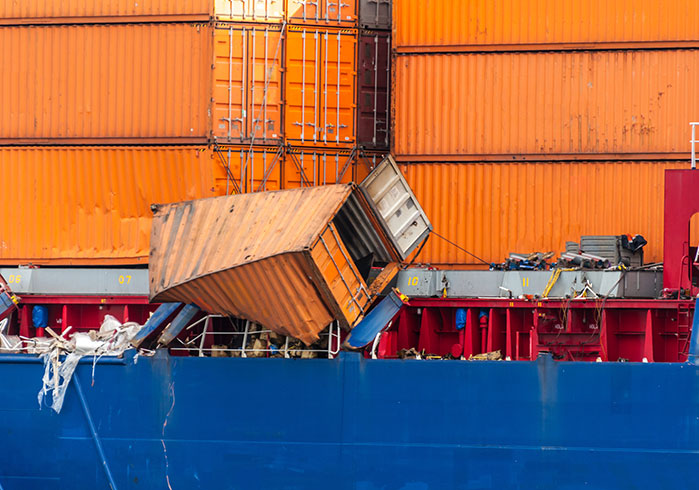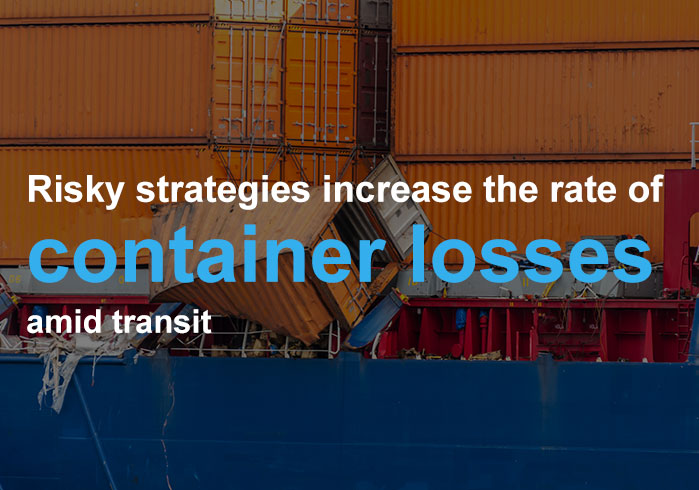
The shipping industry is currently dealing with severely strained container availability. One of the effects of this situation is that cargo ships are losing an increasing number of containers overboard. The comparative statistics of the 30th of November 2020 against the 31st of January 2021 indicate a dramatic spike in just two months.
There are only a limited number of options that are open to shippers when goods are involved in an accident. This includes events that are caused or worsened by the weather conditions. One of the options that can be used is to ask the insurer to cover part of or all the replacement costs. However, that option is only available to those who have an adequate, up-to-date insurance policy.
It is in the interest of companies to have a contingency plan that not only prevents accidents but also ensures that losses are minimized following an accident. As a starting point, companies must try to understand why accidents are increasing during this time. Then, the next stage is to consider the risks and alternatives so that they make the best decision. Ultimately, this is about protecting the supply chain from events that are unexpected and largely outside of your control.
The Demand for Shipping
One of the reasons for the increase in accidents is the demonstrably high demand for shipping space. To meet the demand, shipping companies are stacking large quantities of cargo on increasingly narrow equipment. In the past, this would have been the time for a slower shipping period. However, that has not happened this time because more and more companies want to quickly ship their cargo in the aftermath of the COVID-19 pandemic.
There is more demand for e-commerce and shipping is very much part of that supply chain, particularly if you are talking about the two economic giants of the world: the USA and China. The slow-down that usually happens in the winter has not happened this year. If anything, demand has increased every passing day.
At a time when the holiday rush is supposed to be receding, there is an increasing demand for shipping services. The Chinese New Year and inclement weather have added a sense of urgency to virtually all shipments. Ships need to be moving throughout the season, regardless of weather and holidays. It is a logistical nightmare trying to keep with demand that is not satisfied by the number of available ships.
The newer ships are stacking up to 10 levels and this is just too precarious. Even as the ships are getting bigger, there are concerns that they cannot cope with all the loads that are being placed on them. The new Ultra Large Container Ships (ULCS) are supposed to cope with all that is thrown at them. Even the resultant increase in TEU capacity since 2018 has not been able to quite satisfy the current demand.
Therefore, dangerous boundaries are being pushed to their limits. These gigantic vessels are designed to roll and pitch. However, when you increase the load to a certain height you run the risk of destabilizing the vessel. This can be seen when the ships start to sway or even topple as they are piled high with cargo.
The latest incident involved a 260-container loss which happened near Japan in February, 2021. Inclement weather was part of the problem. However, some experts are convinced that these vessels are being overloaded to meet the increasing demand. Therefore, it is expected that at some point industry regulators will place restrictions on the stack height for vessels such as the ULCSs. Such a move, if it happens, would restrict shipping capacity even more than it is now.
Assessing Risk
Businesses need to make a considered risk assessment as they load these vessels. The costs of compensating for lost cargo can be much higher than those that are incurred by saying no to excess cargo. Whereas the industry is generally safe and container dumps are not the norm; when they do happen, they cause a lot of damage. There was an incident involving ONE Apus, resulting in more than 1800 containers going overboard at the close of November 2020.
For context, this was the second-largest cargo loss in the entire history of shipping. Some estimates indicate that a total loss of $200 million is likely. These are costs which the shipping industry can not afford when it is trying to get a hold of the increasing demand for space.
One of the expected responses was a declaration of a general average to offer guidance and support to shipping companies. This would allow for financial liability for losses to be shared across all shippers who had goods on the sailing. The idea would be that those with unharmed cargo would help those that had lost cargo so that risk was shared.
That hope does not seem to be coming to fruition given events such as the ONE Apus incident which have dented customer confidence. That means that shippers must negotiate specific arrangements with their insurers. Otherwise, they will have to deal with inventory gaps that are hard to bridge if their cargo is on board and in transit.
Other issues arise when vessels collapse. For a start, the removal is a significant undertaking that requires lots of resources. Moreover, there is a waiting process before the unharmed cargo can get to its destination. That can add months to the usual supply routes. For example, by the third week of February 2021, only 943 had been unloaded from ONE Apus.
Keeping Cargo Safe
Perhaps the better option is to ensure that cargo is safe throughout shipping. Businesses do this by hedging risks. This can be done by setting up chain redundancies that can be relied on in case there is a major incident. In these cases, some backup suppliers can come to the rescue and ensure that the end customers get their goods.
Failure to do this means that businesses may have to replace lost goods directly from the original suppliers. This depends on the product cycles that are relevant to the cargo. Others may have to wait until production is done again. Then there is the option of booking expensive air freight that can make up for the time that has been lost.
Then there is the option of getting clear and comprehensive insurance policies. Flexible insurance policies have the advantage of covering goods regardless of their location. It is an improvement on those restricted policies that are linked to locations, lanes, or even ports.
This is an age of rerouting if there is an emergency or blockage somewhere. The COVID-19 pandemic has conditioned the industry to expect the unexpected. These last-minute changes can cause delays and the shipper does not want to be restricted by the terms of their insurance policy.
It also makes sense to engage in a sophisticated and detailed financial crisis. This can happen before an accident happens. The company should be aware of any costs and delays that it may have to contend with so that it can plan. Some of the things to consider include deductibles, documentation, time costs, premium increments, and replacement modalities. Such plans should include a short-term and long-term aspect.
Cargo insurance is only a fraction of the value of goods in transit. Those who fly on hope may be disappointed, yet insurance is quite affordable. Insurance should be a matter of course and businesses should ensure that they are always up to date.
It makes sense to go for those packages that are zero deductible. Moreover, it is better to work with insurers that do not have extended, bureaucratic processes for making a claim. Select policies that cover you regardless of location or route.
Wrapping Up
There is a lot of demand for shipping space. That means that shipping companies are beginning to take risks by overloading cargo. The consequence is an increase in costly accidents. Businesses should do a risk assessment and contingency plan to mitigate these problems. At the heart of the solution is the need to find insurance policies that are flexible and comprehensive enough to assist your company in case there is an accident with your cargo on board.


